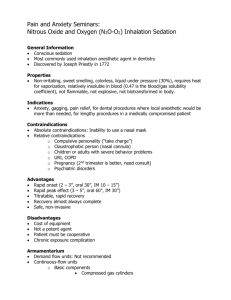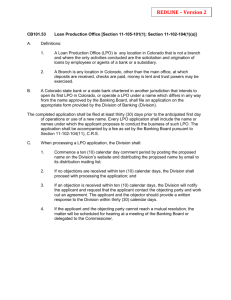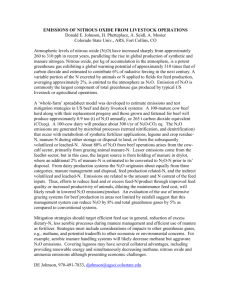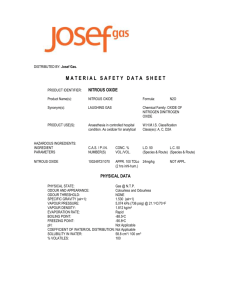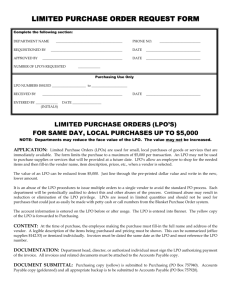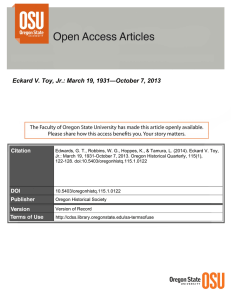Best management practices for nitrogen in intensive pasture
advertisement
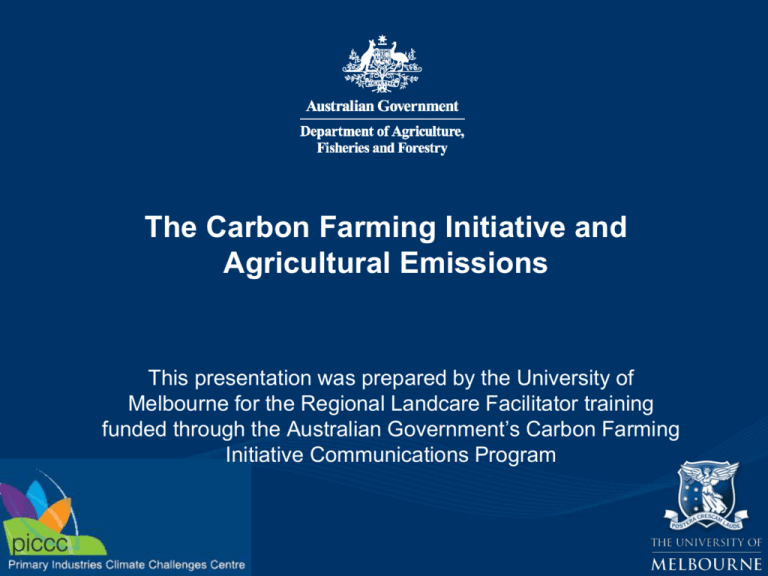
The Carbon Farming Initiative and Agricultural Emissions This presentation was prepared by the University of Melbourne for the Regional Landcare Facilitator training funded through the Australian Government’s Carbon Farming Initiative Communications Program PART 8: OPTIONS FOR ABATEMENT – EMISSION REDUCTION This presentation provides options to reduce methane and nitrous oxide emissions from agricultural systems Options for abatement - Methane Technologies to Reduce Enteric Methane Emissions Animal Manipulation Diet Manipulation Rumen Manipulation Forage quality Animal Breeding Residual Feed Intake Biological Control Plant Breeding Bacteriophages bacteriocins Efficiency Reductive Acetogenesis Dietary Supplements Management Systems Dietary Oils Alternative livestock systems Vaccination Probiotics Unproductive Animals Enzymes Chemical Defaunation Dicarboxylic acids Plant Secondary Compounds Tannin & Saponin Eckard 2008 Options for abatement - Methane Mitigation % “Silver bullet” 45 40 35 30 25 20 15 10 5 0 Biological control Vaccination Dietary Supplements Rumen manipulation Breeding BMPs Herd Management Low Immediate High Medium Likely Impact High Timeline Longer Term Confidence Low Eckard, Grainger & de Klein 2010 Options for abatement - Methane • Measurement – in vitro – Test tubes – Continuous Culture AgResearch, New Zealand Options for abatement - Methane • Measurement – SF6 (sulphur hexafluoride)Tracer • Individual animals in the field Permeation tubes Evacuated yolk/canister Grainger, Eckard et al. 2007 Options for abatement - Methane • Measurement – Chambers/Calorimeters • Individual Animals Grainger, Eckard et al. 2007 Options for abatement - Methane • Measurement Reflector – Open Path laser or FTIR tracer Wind Reflector FTIR Laser FTIR Griffiths et al. 2007; Phillips et al. 2009 Options for abatement - Methane • Short term – Feed quality • Pasture improvement • C3 pastures, legumes – Dietary supplements • Grain • Tannins • Oils – 1% fat = 3.5% decrease CH4 /kg DMI Eckard et al. 2010; Moate et al. 2010 Options for abatement - Methane • Short term – Improving farm efficiency / animal numbers • Extended lactation • Earlier finishing of beef • Reproduction, weaning percentages, fertility & health – Alternative livestock systems • Monogastrics & kangaroos? – Pigs & chooks cannot covert grass into food Eckard et al. 2010 Options for abatement - Methane • Medium Term – Animal Breeding • Feed conversion efficiency • Reduced methanogenesis – Plant Breeding • Improved energy to protein ratio • Tannin, oils, sugars Eckard, Grainger & de Klein 2010 Options for abatement - Methane • Longer-term – Rumen manipulation/ biological control • • • • Vaccination Competitive or predatory microbes Acetogenesis (Kangaroo) Succinate (Tamar Wallaby) Eckard, Grainger & de Klein 2010 Options for abatement – N2O Technologies to reduce Nitrous Oxide emissions Animal Soils Physical interventions Restricted Grazing Feed Conversion Efficiency Breeding Plant breeding eg. tannins Dietary Interventions Chemical Intgerventions Balancing Protein: Energy Salt Nitrification inhibitor in urine Fertiliser Rate Waterlogging / drainage Source Irrigation Timing Compaction Effluent Management Controlled Release Nitrification Inhibitors Eckard 2008 Options for abatement – N2O “Silver bullet” 25 Biological control Animal Breeding Mitigation % 20 15 Nitrification Inhibitors 10 BMPs 5 Diet Plant Breeding Soil Microbial Manipulation Secondary plant compounds Herd Management 0 Low Immediate High Likely Impact Medium High Timeline Longer Term Confidence Low De Klein & Eckard 2008 Options for abatement – N2O • Measurement of N2O – Manual and automatic chambers Options for abatement – N2O • Measurement of N2O – Micrometeorological methods Options for abatement – N2O • Short term - Nitrogen Fertiliser Rate • Match to plant demand • Similar with effluent 15 14 13 12 11 10 9 8 7 6 5 4 3 2 1 0 Environment 11.7 8.1 30 Annual N2O emission (kg N/ha.y) Predicted Pasture Growth (t DM/ha.y) Productivity 13.3 6.0 8.5 11.2 Urea Nitrate Urea Nitrate 25 20 15 10 5 0 0 100 200 300 400 500 600 Annual N Fertiliser Rate (kg N/ha.y) 700 800 900 0 100 200 300 400 500 600 Nitrogen Fertiliser Rate (kg N/ha.y) Eckard et al. 2006 Options for abatement – N2O • Short term - Nitrogen fertiliser rate Nitrous oxide-N (kg/ha) 10 Cotton 8 Wheat-VetchCotton Wheat-Cotton 6 4 2 0 0 100 N rate 200 300 Grace et al. 2007 Options for abatement – N2O • Short term - Choice of N Source • In wet soils – N2O (nitrous oxide) from NO3-N (nitrate) source – Denitrification or leaching • In dry soils – N Placement • Band, ridges • Within paddock Annual N2O emission (kg N/ha.y) – N2O (nitrous oxide) from NH3 (ammonia) 30 – Volatilisation from urea Urea 25 Nitrate 20 15 10 5 0 0 100 200 300 400 500 600 Nitrogen Fertiliser Rate (kg N/ha.y) Eckard et al. 2006 Options for abatement – N2O • Short term - N Source and timing 1.8 Control Ammonium nitrate Urea 1.6 1.4 Nitrous Oxide loss (kg N/ha) 1.2 1.0 0.8 0.6 0.4 0.2 0.0 Autumn Winter Spring Summer Eckard et al. 2002 Options for abatement – N2O • Short term - Fertiliser formulation – Urease inhibitors • Reduces NH3 (ammonia) volatilisation – eg. Agrotain®, Green UreaTM – Nitrification inhibitors • Reduces N2O (nitrous oxide) and ENTEC® NO3 (nitrate) leaching • Temperature sensitive – eg. DCD, Nitrapyrin, DMPP De Klein & Eckard 2008 Options for abatement – N2O • Short term - N formulation – Nitrification Inhibitor sprays on pasture • 50% less N2O – for 50 days mid-spring • 25% less N2O – for 25 days in summer Kelly et al;. 2008 Options for abatement – N2O • Short term - N formulation – Controlled Release/Coated Fertilisers • Polymer or oil-based coating – Controlled pattern/rate of release – Slow Release Fertilisers • Reduced solubility – Chemical – Physical mixing • Slower release of N De Klein & Eckard 2008 Options for abatement – N2O • Short term – Soil Water / irrigation Granli and Bøckman (1994) Options for abatement – N2O • Short term - Soil Management – Limited grazing on wet soils/ use of feedpads – Soil structure • Reduce waterlogging with N • Reduce soil compaction with N – Stubble management • Retain stubble • Conservation tillage and controlled traffic • Build soil organic matter – Reduce fallow • Loss of unutilised N • Cover crops De Klein & Eckard 2008 Options for abatement – N2O • Medium term – Plant breeding • Tannin content • Less N required • Longer term – Rumen manipulation – Soil microbial manipulation – Animal breeding • More N efficient “Silver bullet” 25 Biological control Animal Breeding Mitigation % 20 15 Nitrification Inhibitors 10 BMPs 5 Diet Plant Breeding Soil Microbial Manipulation Secondary plant compounds Herd Management 0 Low Immediate High Likely Impact Medium High Timeline Longer Term Confidence Low De Klein & Eckard 2008 Options for abatement – N2O • Urine Management • Ruminants excrete 75 to 95% of N intake • Short Term – Balancing ME:CP – Feed tannins – Animal numbers • Reduce hot-spots – Inhibitors • Longer Term – Breeding • Improve animal FCE • Improve plant – ME:CP – tannins • Inhibitor spray Grainger et al. 2009; De Klein & Eckard 2008

